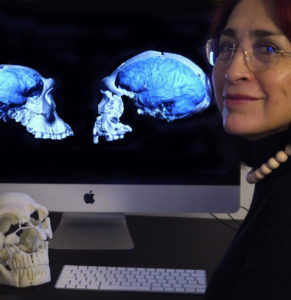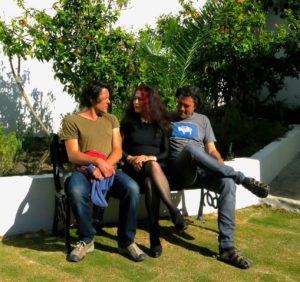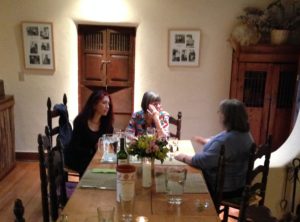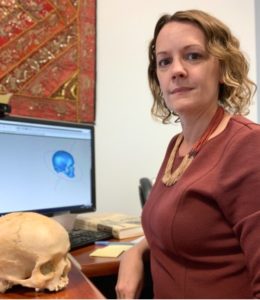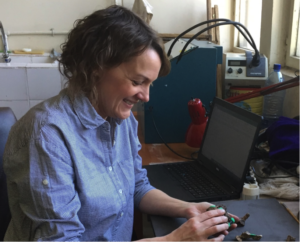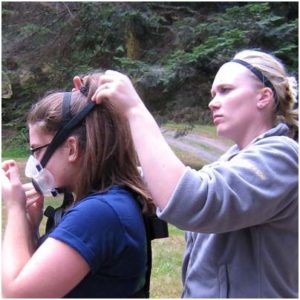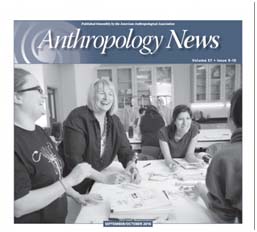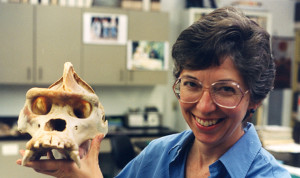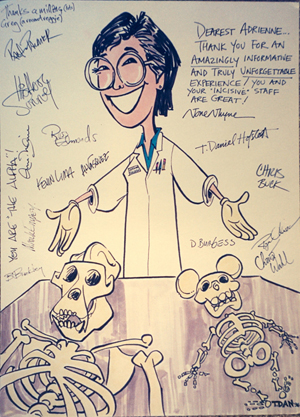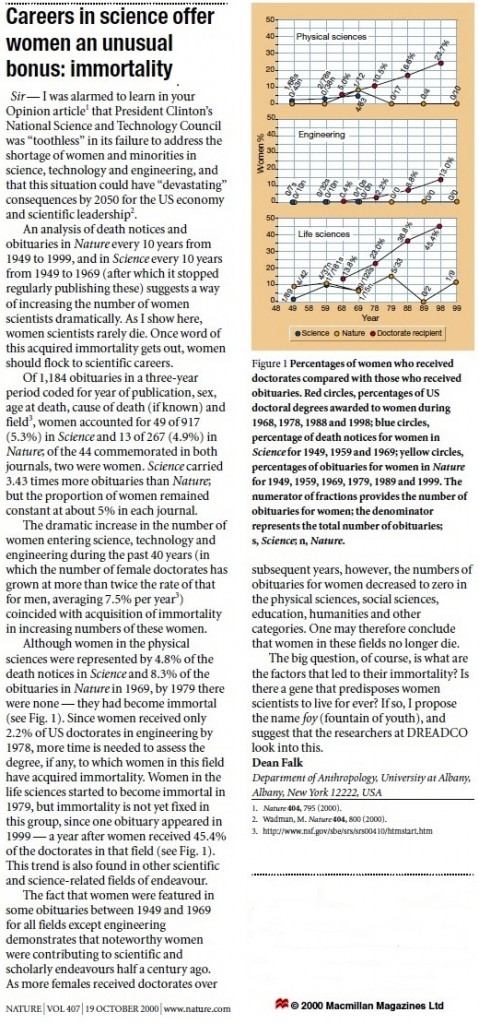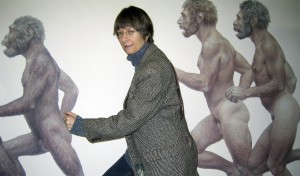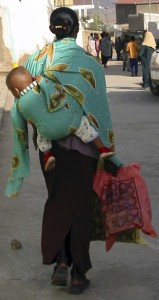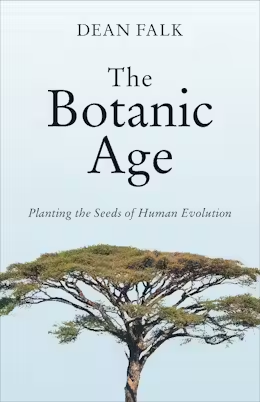Holly Smith is an American biological anthropologist who is a pioneer in the field of evolutionary developmental biology (“evo-devo”) that focuses on how stages of life such as the timing of birth, weaning, growing and dying evolved in mammals. More specifically, she has unraveled the patterns of development that evolved in the human lineage. Professor Smith is currently at the Center for Advanced Study of Human Paleobiology at The George Washington University and a researcher at the University of Michigan Museum of Anthropological Archaeology. Her research on dental development in living and fossil species draws upon her field and museum experiences in European, African, and Asian countries.
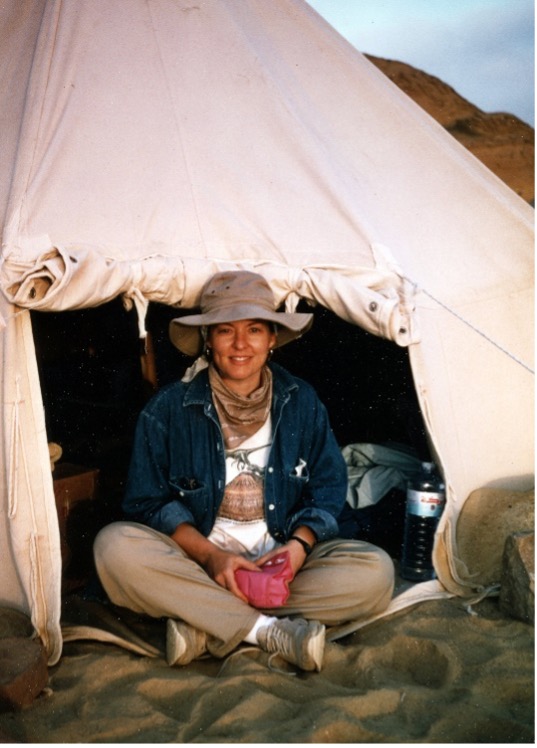
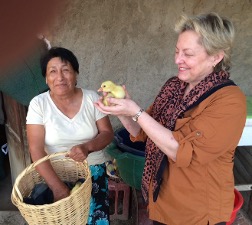
Professor Smith has participated in expeditions hunting for and finding fossil whales in Egypt (left) and Peru (right).
Professor Smith has compared dental development in important fossil hominins such as the Nariokotome (Homo erectus) skeleton from Kenya and made crucial discoveries about the patterns and emergence of the slow development rates that characterize humans. Although she is perhaps most famous for her discoveries about how developmental stages evolved in our ancestors, Dr. Smith has just published an article that integrates dental and life history information from 71 species of contemporary mammals that reveals how infant development is tied to seasonal cycles. This landmark article (“Mammalian Life History: Weaning and tooth Emergence in a Seasonal world,” https://www.mdpi.com/2079-7737/13/8/612) is the culmination of decades of meticulous research and builds a framework for analyzing the entire fossil record for mammals within an environmental context.
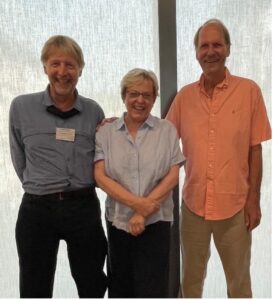
Holly Smith at a conference in Germany in 2022 with fellow scientists Professor Christopher Dean and Professor Tim Bromage.
Contact information for B. Holly Smith:
bhsmith@umich.edu
https://twitter.com/LemurLove2
Marcia S. Ponce de León is an internationally renowned expert in evolutionary developmental biology of fossil and modern hominins and great apes.
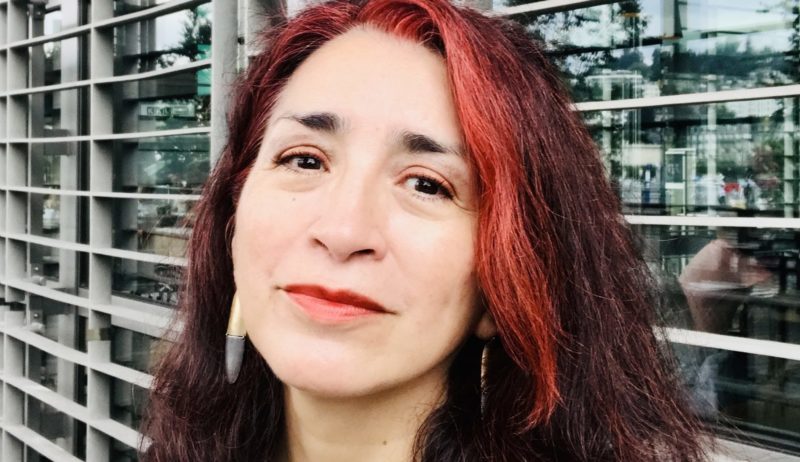
Dr. Ponce de León is senior research associate at the Department of Informatics, University of Zurich, Switzerland, and at the IBS Center for Climate Physics (Busan, South Korea). Her research focuses on the evolution of the modern human birth process and the development of the brain and face. She also studies pathology and aging in fossil hominids and extant humans, and the out of Africa dispersals of hominids as seen from combined genetic/phenetic evidence. She has worked on many of the most important hominin fossils ranging from the earliest recognized hominins (Sahelanthropus) to Neanderthals. Dr. Ponce de León is a leading pioneer in developing Computer-assisted Paleoanthropology (CAP) as a new research field in evolutionary anthropology, and she initiated the “Virtual Ape Project”, which seeks to gather high-quality biomedical imaging data of recently deceased great ape individuals from zoos and sanctuaries. She served as curator of the primate and osteoarchaeological collections at the Anthropological Institute at the University of Zurich, Switzerland, which include the famous A. H. Schultz collection of apes.
- Dr. Ponce de León with the Dutch twins Adrie and Alfons Kennis, her favorite paleoartists, at the museum of Gibraltar.
- Dr. Ponce de León at an inspiring workshop at the School for Advanced Research (SAR) in Santa Fe, New Mexico.
You can read more about Dr. Ponce de León’s career here:
http://deanfalk.com/wp-content/uploads/2022/08/Marcia-Silvia-Ponce-de-León-CV.pdf
Here is a list of her peer-reviewed publications from 2012-2022:
http://deanfalk.com/wp-content/uploads/2022/08/Marcia-Silvia-Ponce-de-León-Publications.pdf
Un día en la vida de Marcia Ponce de León, boliviana y antropóloga en la Universidad de Zúrich:
https://www.swissinfo.ch/spa/marcia-ponce-de-le%C3%B3n-_el-desaf%C3%ADo-de-investigar-nuestros-or%C3%ADgenes/43902732
Karen Baab is a paleoanthropologist who studies variation and evolution of extinct species in our own genus, Homo.
She is a pioneer in high dimensional shape analysis in paleoanthropology, investigating differences among fossils using three-dimensional shape analysis. Much of her key work has focused on understanding the evolutionary history of two particular species, Homo erectus and Homo floresiensis. Dr. Baab’s research supports clear changes to skull shape through time, but also across regions, in Homo erectus. Her contributions were central to the acceptance of Homo floresiensis as a new species and not a pathological modern human. Her recent work uses quantitative genetic models to test the relative impact of random evolutionary events, like genetic drift, and nonrandom events (natural selection) during human evolution. This line of investigation highlighted higher individual and group variation in Homo erectus than in recent humans, implying different evolutionary history in these geographically dispersed species. Her ongoing research concerns virtual reconstruction of fragmentary fossils, development of skull shape in Homo erectus from birth to adulthood, and testing for signals of natural selection related to chewing biomechanics in extinct human species spanning the Plio-Pleistocene boundary.
Departmental and Personal Web pages:
Interviews on Evolution Soup (YouTube):
Homo floresiensis: https://www.youtube.com/watch?v=rMiDgHvaiFw
Homo erectus: https://www.youtube.com/watch?v=7N7JrQcLJVs
Open Access Publications:
Homo floresiensis: https://journals.plos.org/plosone/article?id=10.1371/journal.pone.0069119
Homo floresiensis: https://journals.plos.org/plosone/article?id=10.1371/journal.pone.0155731
Cara Wall-Scheffler is an evolutionary anthropologist who focuses her work on evolutionary trade-offs.
Some of her key interests include the trade-offs of body shape, body size, and metabolic energetics. Most of her work has centered around the locomotion and mobility strategies of bipedal females, particularly during the Pleistocene. She has investigated the role of pelvis shape and locomotion while load carrying among humans and Neanderthals, and has paid special attention to physiological ramifications of body shape and size, particularly as they change thermoregulation and energy. Her main contributions include the idea that women’s morphology does not involve tradeoffs for locomotion, and that human running has likely had only a small influence on human morphology worldwide.
You can read more about her work here:
https://wallscheffler.wordpress.com/
in her book on the evolution of the pelvis:
and on Twitter here: @WallScheffler
Professor Wall-Scheffler adjusting the face mask to measure energy expenditure of a participant during field work in the San Juan Archipelago
Debra L. Martin is a leading researcher into the origins and evolution of violence in early human groups.
She is a skeletal biologist and bioarchaeologist who focuses on small scale societies in the past. She was awarded the Distinguished Professor in 2018 and she the Harry J. Reid Silver State Distinguished Research Award in 2015 from the University of Nevada where she continues to work. Using data derived from the analysis of trauma and disease from ancient bones, she has investigated the patterns and cultural meanings of violence across cultural and geographically distinctive early societies. She has co-authored or co-edited 13 books focused on various forms of violence including Bioarchaeology and Forensic Approaches to Massacres, Bioarchaeological and Forensic Perspectives on Violence, and Bioarchaeology of Women and Children in Times of War.
You can read more about the research of Dr. Martin at:
https://www.unlv.edu/news/series/our-newest-distinguished-professors
https://www.unlv.edu/news/release/2015-harry-reid-silver-state-award-winner-debra-martin
https://www.unlv.edu/people/debra-martin
Debra Martin is a generous mentor who cares deeply about her students. In this photograph, she is teaching osteology at the University of Nevada, Las Vegas. Her course was highlighted for its pedagogical innovations in using new techniques to engage student’s interests.
Leading Light in Physical Anthropology: Professor Emerita Adrienne Zihlman, UC Santa Cruz
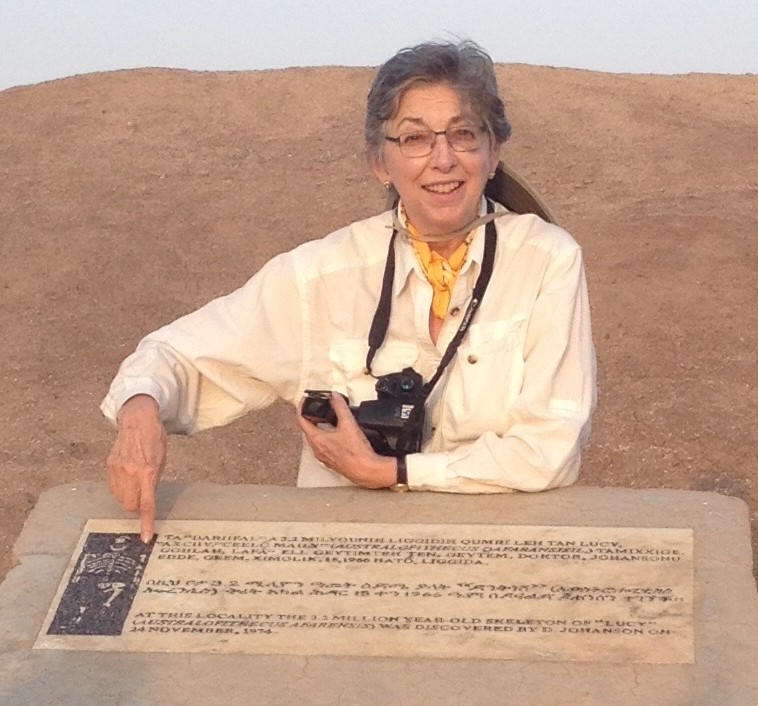
Adrienne Zihlman at the Hadar site in Ethiopia where “Lucy”
(Australopithecus afarensis) was discovered in 1974.
Adrienne Zihlman is a world-renowned comparative anatomist who focuses on great apes and contemporary humans. Her research integrates quantitative information from flesh, bones, and muscles, and is extremely important for analyzing the bodies and behaviors of early human relatives. She is the author of the critically-acclaimed (and widely used) The Human Evolution Coloring Book, coeditor of The Evolving Female, and coauthor of a soon-to-appear book on comparative ape anatomy. Dr. Zihlman was at the forefront of the movement that successfully critiqued the “Man-the-Hunter” hypothesis, and her research was crucial for the recognition that women played a major role in making us human. In April, 2015, the Department of Anthropology at the University of California, Santa Cruz, named and dedicated the Adrienne Zihlman Physical Anthropology Lab .
You can read more about Professor Zihlman’s accomplishments at:
http://people.ucsc.edu/~azihlman
To read about Adrienne Zihlman’s wonderful new book (with Carol E. Underwood), Ape Anatomy and Evolution (2019), see https://apeanatomyevolution.com/
Comment on the Inspirational Life of Evolutionary Scientist Doris F. Jonas (1916–2002)
Very few women receive credit for having pioneered research in the evolutionary sciences. For example, it is standard for contemporary biological anthropology textbooks to mention fossil collector Mary Anning (1799–1847) as the only token woman in chapters about the early development of evolutionary theory (e.g., see Jurmain, Kilgore, and Trevathan, 2011). It is, therefore, an inspiration to learn of the life and career of Doris F. Jonas (1916–2002) who, along with her husband David, pioneered numerous approaches to evolutionary anthropology, psychology, and medicine (Winkler, 2012). (Lists of Doris and David Jonas’s many and varied publications are provided by Winkler [2012]). Among other topics, Doris Jonas researched and wrote about the anthropology and evolution of aging, human sexual behavior, mental illness, growth and development, and language origins. With respect to the latter, her observations regarding the role of mother-infant bonding in language origins were especially prescient.
Doris Jonas obviously had a voracious intellectual curiosity about nature, which she pursued and wrote about without benefit of a formal education. It was only after she was recognized as a published scholar that Jonas earned an M.S. in social anthropology from the University of London in 1982, which she did without having first earned a bachelor’s degree (Winkler, 2012). Doris Jonas balanced her avid intellectual interests with multiple marriages and having children. As Winkler notes, “Doris tried to lead the life of a typical housewife of the 50s.” At that time, “The Adventures of Ozzie and Harriet” (an iconic American television sitcom of the 1950s and 1960s) reflected society’s expectations for women—namely, that they be stay-at-home moms who derived their satisfaction from their husbands’ achievements and raising their children. They most certainly did not pursue intellectual interests or scholarly careers. That Doris Jonas was prolific as a scholar and writer under these circumstances is remarkable. The fact that, later in life, “she felt more and more that her work had not been appreciated and that [former husband] David had passed off her ideas as his own” (Winkler, 2012) is sad, but not surprising.
Clearly Doris Jonas was an extraordinary woman and evolutionary scientist. As an aside, it is interesting that another female scholar who was born less than two decades after Doris Jonas’s birth, world-renowned chimpanzee expert Jane Goodall (1934–), followed a similar trajectory of pursuing her intellectual interests in zoology and evolution, earning an advanced degree from a British university only after her published research was recognized and without benefit of first obtaining a bachelor’s degree (Ph.D., Cambridge University, 1965), experiencing multiple marriages, and having a child. So aspiring female scientists everywhere should take inspiration from the likes of Doris Jonas and Jane Goodall. They pursued their intellectual interests relentlessly, engaged in a good deal of self-training followed by earning advanced degrees, and managed to have families. So, too, can you!
Jurmain, R., Kilgore, L., Trevathan, W. (2011): Essentials of Physical Anthropology, 8th edition. United States: Wadsworth CENGAGE Learning.
Winkler, P., 2012: Doris F. Jonas – Pionierin der evolutionären Anthropologie, Psychologie und Medizin – ein geschichtlicher Beitrag, in: Idiolekta – die Eigensprache in Forschung und Praxis 01/2012, Wurzburg, Huttenscher Verlag 507.
Women in Science
As noted, evolution is about who lives and who dies, otherwise known as “differential mortality.” Some years ago, I wrote a tongue-in-cheek commentary about immortality in women scientists based on an analysis of death notices and obituaries in Science every ten years from 1949 until 1969 (after which it regularly stopped publishing these) and every ten years in Nature from 1949 to 1999. Although over a decade has passed since the commentary appeared, my perusal of the same two journals suggests that women scientists can continue to celebrate their differential immortality. For fun, the commentary is reproduced below.
Women in Evolution
Animal breeders knew how to obtain lineages with desirable characteristics long before Charles Darwin formulated the theory of natural selection to explain how new species emerge from earlier ones. Taking a cue from animal husbandry, Darwin understood that the differences between current and future generations depend largely on which individuals reproduce, and which do not. At its most basic level, evolution is manifested in changed frequencies of characteristics as they are inherited from one generation to the next (microevolution). For example, if 50% of one generation has blue eyes, but only 40% of the next generation does, then microevolution has occurred. Depending on geographical circumstances and time, the cumulative effects of generation-to-generation changes may result in the emergence of new species (macroevolution). In both cases, evolution boils down to who lives and who dies.
Genetic studies reveal that our closest nonhuman cousins are the chimpanzees, and that we are a little more distantly related to the other great apes (gorillas and orangutans). Numerous scientific studies also show that our direct ancestors (hominins) split from those of chimpanzees around five to seven million years ago. Paleoanthropologists make educated guesses about what early hominins were like by studying the hominin fossil record, comparative anatomy, primate behavior, and the lifestyles of people living in non-industrialized societies. The best guess is that our earliest hominin relatives lived in social communities in which males did some hunting and scavenging for meat, while females focused more on gathering plant foods. Paternity would not have been understood, and mothers and nursing infants would have been inseparable. Small groups of females and juveniles probably foraged together during the day, and reunited with the larger community before settling in trees to sleep at dusk.
But how do we get from this very apelike picture of early hominins to the Homo sapiens that we know and love today? Certain clues help to answer this question. We know that our ancestors became adept at walking on two legs, developed increasingly large and complex brains, invented a variety of tools, became crafty (some would say sneaky) in their social realtionships, and originated language. Paleoanthropologists agree that all of these delopments profoundly influenced hominin evolution. Where they disagree, however, is on the identification of the sex that was chiefly responsible for the evolution of these advanced hominin traits.
The classic literature in anthropology has been extremely male-biased when it comes to designating the primary movers and shakers of human evolution. Thus, males are hypothesized to have invented tools and language in conjunction with hunting (and, some would add, warfare). According to this man-the-hunter hypothesis, big brains were selected in males in conjunction with these activities, and brain size in women increased only because they rode on the gentic coattails of their betters. More nuanced social communication, with stronger male-male bonds, is also included as part of the hypothetical masculine evolutionary package. Beginning in the 1970’s, it became widely acknowledged that foraging women in non-industrialized societies actually bring home most of the calories, which led to the woman-the-gatherer hypothesis. That hardly made a dent in the profession’s male bias, however. One researcher even suggests that walking upright was selected for in male hominins so that they could carry plant food that they (the men) had gathered to females, who were seen as too burdened with youngsters and too helpless to fend for themselves!
Inconvenient facts have not interfered with the man-the-hunter/gatherer/inventor hypothesis. For example, among higher primates documented to have invented new techniques or tools (great apes, Japanese macaques), it is usually (if not always) the females who do the initial inventing, and frequently juveniles who spread the inventions. Similarly, the relatively recent human invention of Nicaraguan Sign Language for the deaf was carried out by children. The origin of language was crucial for human evolution, and extensive scientific evidence from multiple disciplines suggests that women and children initiated the invention of language, as detailed in Finding Our Tongues: Mothers, Infants & the Origins of Language.
But the most inconvenient truth that is relevant to the roles of the sexes during hominin evolution goes back to the first paragraph in this section. In its essence, evolution depends on who lives and who dies. The qualities selected for in future generations are determined by the babies who survive, grow up, and have their own babies. Now go back to our apelike picture of early hominins, in which mothers and nursing infants are inseparable and spend their days foraging in the company of other females and youngsters. As is the case for living apes and humans in traditional societies, infant mortality would have been high. The hominin babies who charted the destiny of our species were the ones that lived. Somebody had to keep them alive, and that responsibility fell to their mothers. Early hominin women were, thus, the ones who facilitated the genetic legacy of Homo sapiens. In that sense, they were the mothers of us all.

